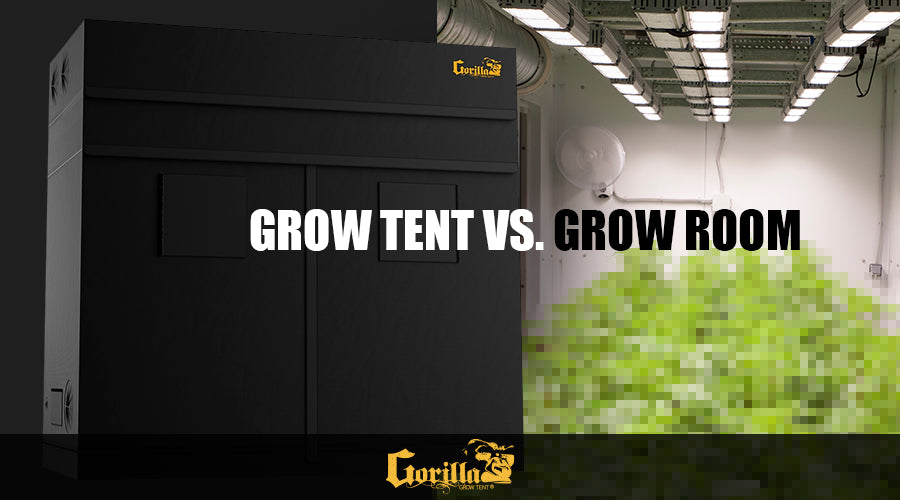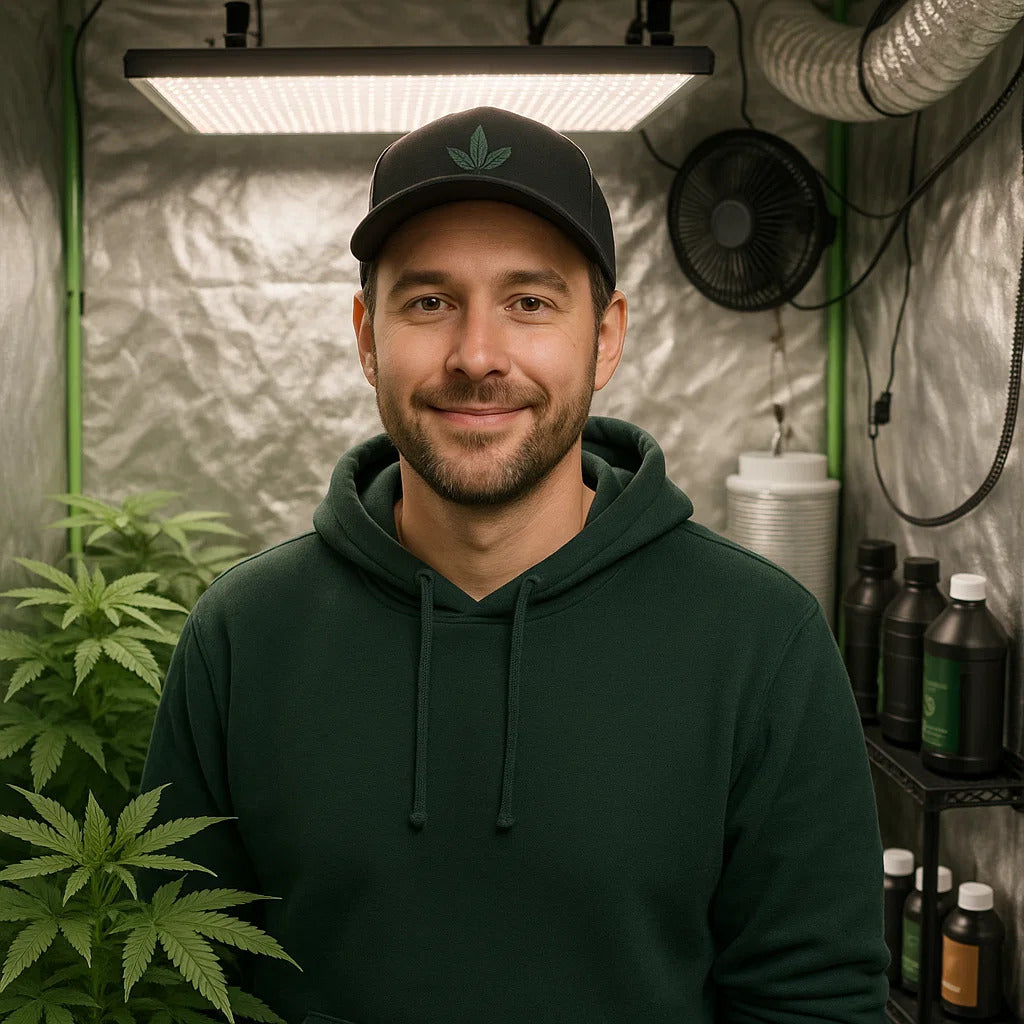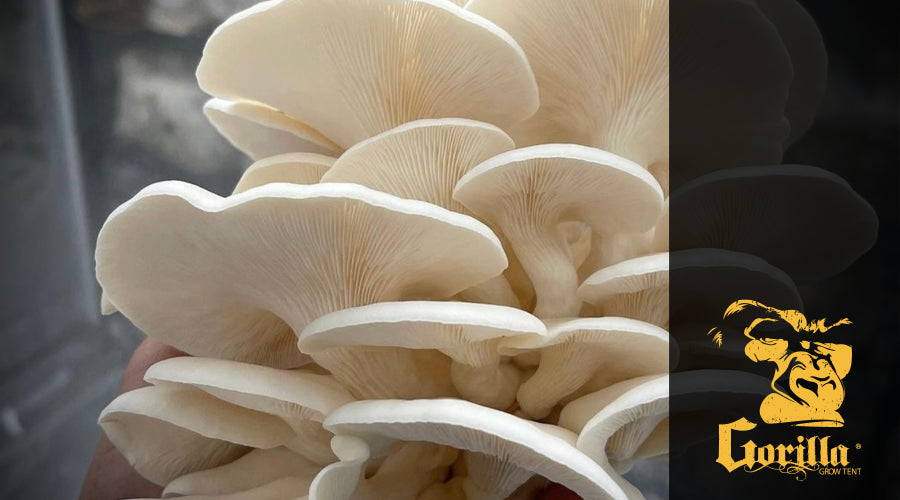
Grow Tent vs. Grow Room: Choosing the Ideal Indoor Growing Space
As the popularity of indoor gardening continues to soar, more and more enthusiasts are turning to controlled environments for cultivating plants. When it comes to indoor gardening, two primary options stand out: grow tents and grow rooms. Both offer unique advantages and are designed to cater to different needs.
In this blog article, we will explore the differences between grow tents and grow rooms, helping you make an informed decision for your indoor gardening endeavors.

Comparing Grow Tents and Grow Rooms
What is a Grow Tent?
A grow tent is a portable, self-contained indoor growing space made from a sturdy, light-reflective material. These tents are available in various sizes, ranging from compact setups for a few plants to larger structures capable of accommodating a considerable garden. Grow tents come equipped with ventilation ports and access points for electrical cords and often include hanging bars to support grow lights and other accessories.
Advantages of Grow Tents
Affordability and Flexibility:
Grow tents are generally more budget-friendly than building a dedicated grow room. Their portability allows growers to rearrange their gardening space easily or even move it if needed.
Easy Set-up:
Setting up a grow tent requires minimal effort and no construction skills. Most tents come with clear instructions and are ready to use quickly.
Controlled Environment:
Grow tents offer a controlled environment for your plants, allowing you to regulate factors like temperature, humidity, and light cycles more efficiently.
Odor Control:
Grow tents often come with carbon filters that help to reduce and control strong odors associated with indoor gardening.
Pest and Disease Management:
The enclosed design of grow tents can act as a barrier against pests and diseases, preventing them from spreading to other areas of your home.
What is a Grow Room?
A grow room, on the other hand, refers to a designated space within a building that is specifically designed and set up for indoor gardening. Unlike grow tents, grow rooms are typically custom-built and may require more extensive planning and investment.
Advantages of Grow Rooms
Larger Growing Capacity:
One of the significant advantages of grow rooms is the ability to accommodate a larger number of plants. This makes grow rooms ideal for commercial growers or individuals with extensive gardening projects.
Customization:
Grow rooms allow for more customization options, including tailored ventilation systems, lighting arrangements, and irrigation setups, all of which can be optimized to suit the specific needs of the plants being cultivated.
Long-Term Investment:
While the initial cost may be higher than that of a grow tent, a well-designed grow room can be a long-term investment that pays off through increased yields and efficiency.
Accessibility:
Unlike grow tents, which may have limited space to maneuver, grow rooms offer more accessibility, making it easier to tend to plants, prune, and harvest.
Choosing the Right Option
Choosing between a grow tent and a grow room ultimately depends on your gardening goals, available space, and budget. Here are some factors to consider:
The scale of Operation:
Are you a hobbyist with a small number of plants, or do you intend to grow on a larger scale for personal use or commercial purposes?
Budget:
Determine how much you're willing to invest in your indoor gardening setup. Grow tents are more budget-friendly, while grow rooms require a higher initial investment.
Space and Location:
Evaluate the available space in your home or property. A grow tent may be more suitable for limited spaces, while a grow room requires a dedicated area.
Long-Term Goals:
Consider your long-term gardening goals. If you plan to expand your indoor garden over time, a grow room might be the better choice.
Choosing the Right Lighting
When deciding between a grow tent and a grow room, it's crucial to consider the lighting requirements for your plants. Grow tents are often designed with built-in reflective materials to enhance light distribution and prevent loss. However, due to their confined space, they may limit the choice of lighting systems and the number of plants that can be effectively illuminated.
Grow rooms, on the other hand, offer more flexibility in terms of lighting options. With larger space, you can install multiple grow lights, adjust their positioning, and use more sophisticated lighting setups, such as High-Intensity Discharge (HID) lamps, Light Emitting Diodes (LEDs), or T5 fluorescent lights. This versatility can lead to improved plant growth and higher yields.
Climate Control and Ventilation
Maintaining the right environmental conditions is essential for successful indoor gardening. Grow tents typically have built-in ventilation ports, making it easier to set up exhaust fans and ensure proper air circulation. However, managing temperature and humidity can be more challenging in hotter climates or with larger tents.
In contrast, grow rooms allow for more advanced climate control systems. You can customize the ventilation, cooling, and dehumidification to match the specific requirements of your plants. This is particularly beneficial when cultivating sensitive or temperature-sensitive varieties.
Energy Efficiency
Energy efficiency is a critical factor to consider, especially for long-term indoor gardening projects. Grow tents generally require less energy to operate since they have a smaller volume to regulate. This can lead to lower electricity bills and reduced environmental impact, making them a greener option for smaller-scale growers.
However, when comparing larger grow rooms to equivalent grow tent setups, the energy consumption may be higher in the grow room due to the need to maintain a larger volume of air and provide ample light coverage. Nonetheless, advancements in energy-efficient grow lights and ventilation systems can help mitigate this difference.
Noise Considerations
Another aspect to keep in mind is noise. Grow tents typically have smaller fans and ventilation systems, resulting in quieter operation. This can be advantageous if your indoor garden is located in a living area or a space where excessive noise could be a concern.
In contrast, larger grow rooms with more substantial ventilation systems may generate more noise. While this might not be an issue for those with dedicated gardening spaces, it's worth considering if your grow room shares a room with other activities or living areas.
Maintenance and Upkeep
Growing tents and rooms requires regular maintenance to ensure optimal plant growth and prevent mold or pest infestations. Grow tents are generally easier to clean and sanitize due to their smaller size and simple construction.
Grow rooms, being more extensive and possibly incorporating more complex systems, may demand more effort and time for upkeep. However, maintaining a grow room can be streamlined and manageable with proper planning and organization.
Security and Privacy
Security and privacy are essential considerations when setting up an indoor garden, especially if you live in a shared space or urban environment. Grow tents can offer a level of privacy as they are enclosed structures. Since compact and portable, they can be easily concealed in a closet or unused room. This discretion can help maintain confidentiality and prevent unwanted attention.
On the other hand, grow rooms may be more challenging to hide, especially if they occupy a larger area within your home. Security measures, such as locks on doors and windows, become even more critical for grow rooms to safeguard your plants and equipment.
Aesthetics and Home Integration
Considering the visual impact of your indoor garden is another aspect to consider. Grow tents are designed with a neutral appearance and are often sleek, discreet. They blend well with the surroundings and can be easily hidden if necessary, maintaining a tidy and organized look.
Grow rooms, however, may have a more significant impact on the aesthetics of your living space, particularly if you have a sizable indoor garden. Integrating a grow room into your home's layout requires careful planning to ensure it complements the interior design and doesn't clash with the existing decor.
Portability and Future Relocation
If you anticipate the need to move your indoor garden in the future, portability becomes a crucial consideration. Grow tents are designed for easy assembly and disassembly, allowing for relocation without much hassle. This makes them ideal for renters or individuals needing to change their growing space.
Due to their permanent nature, grow rooms are less portable and more suitable for homeowners or those committed to a fixed gardening location. Relocating a grow room would likely involve significant disassembly and rebuilding, which could be time-consuming and expensive.
Learning Curve and Experience
Grow tents provide a straightforward and user-friendly option for beginners and those new to indoor gardening. They often come with basic instructions, making the setup process relatively simple. Grow tents are a great entry point for learning about indoor gardening and getting accustomed to managing environmental factors.
Grow rooms, on the other hand, may have a steeper learning curve. Building and optimizing a grow room requires more research, knowledge, and experience. As a result, they are better suited for experienced gardeners or those willing to invest time in learning the ins and outs of indoor gardening.
Combining the Two
It's worth noting that some indoor gardeners combine grow tents and rooms to create a hybrid growing environment. For instance, you might have a dedicated grow room for larger plants or an extended garden while using a grow tent for starting seedlings or cultivating more delicate or specialty plants. This hybrid approach allows versatility and flexibility, offering the best of both worlds.
The Best Choice for Your Indoor Plants
Whether you opt for a grow tent or a grow room, both indoor gardening solutions have unique advantages and disadvantages. Your choice should align with your gardening goals, available space, budget, and experience level.
Grow tents provide an affordable, accessible, and portable option, making them suitable for beginners, hobbyists, and those with limited space. They offer a controlled environment and can easily integrate into various living spaces.
Grow rooms, on the other hand, are better suited for more ambitious projects and experienced gardeners who are willing to invest in a long-term gardening space. They offer customization, scalability, and potential for higher yields, making them ideal for those looking to take their indoor gardening to the next level.
Whichever path you choose, the joy of nurturing and witnessing your indoor garden flourish is a rewarding experience that transcends the boundaries of indoor and outdoor gardening alike.

Lena Myles
I'm a mushroom enthusiast and home cook based in Oregon. I'm passionate about foraging and creating fungi-focused recipes, especially delicious, plant-based dishes using gourmet mushrooms like trumpet, shiitake, and oyster. When I’m not in the kitchen, you’ll usually find me wandering the woods in search of new wild flavors.


